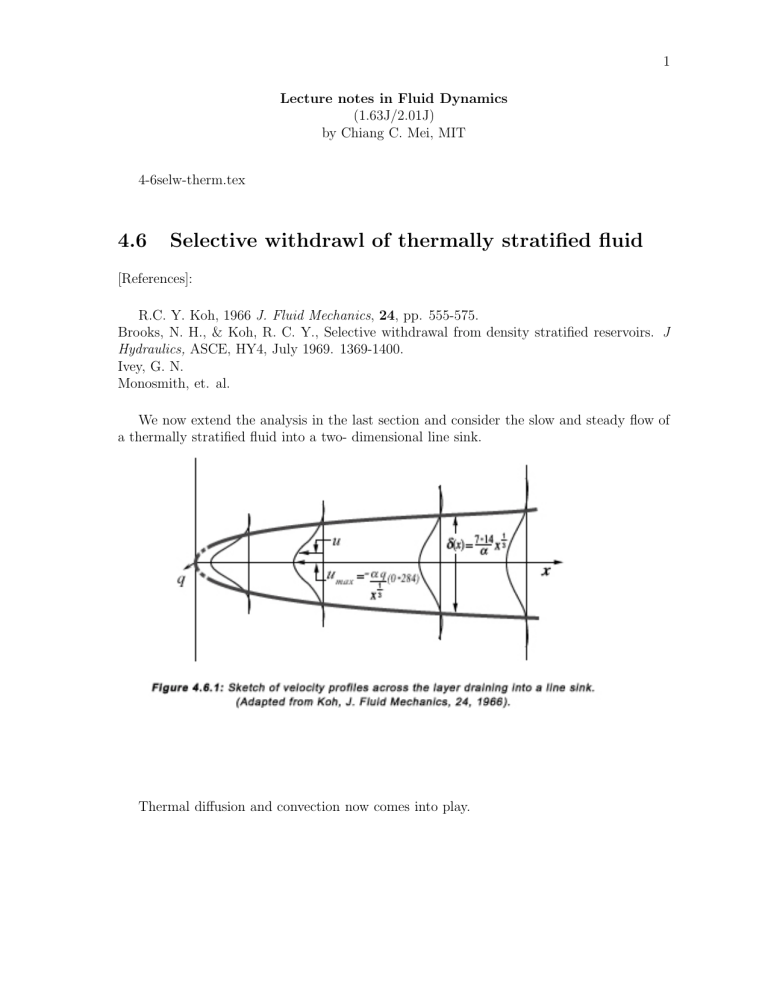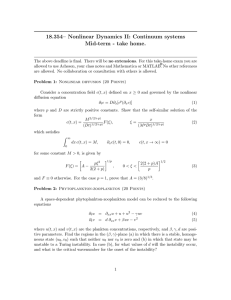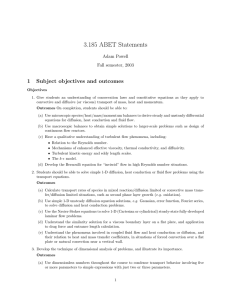4.6 Selective withdrawl of thermally stratified fluid

Lecture notes in Fluid Dynamics
(1.63J/2.01J) by Chiang C. Mei, MIT
4-6selw-therm.tex
4.6
Selective withdrawl of thermally stratified fluid
[References]:
R.C. Y. Koh, 1966 J. Fluid Mechanics , 24 , pp. 555-575.
Brooks, N. H., & Koh, R. C. Y., Selective withdrawal from density stratified reservoirs.
J
Hydraulics, ASCE, HY4, July 1969. 1369-1400.
Ivey, G. N.
Monosmith, et. al.
We now extend the analysis in the last section and consider the slow and steady flow of a thermally stratified fluid into a two- dimensional line sink.
1
Thermal diffusion and convection now comes into play.
2
4.6.1
Governing equations
We begin with the general law of mass conservation
∂ρ
∂t
+
∇ ·
( ρ ) =
∂ρ
∂t
+ q
· ∇
ρ + ρ
∇ · q = 0 (4.6.1)
In environmental problems the range of temperature variation is within a few tens of degrees.
The fluid density varies very little and obeys the following equation of state
ρ = ρ o
[1
−
β ( T
−
T o
)]
∇ · q = 0
(4.6.2) where T denotes the temperature and β the coefficient of thermal expansion which is usually very small. Hence q
· ∇
ρ
ρ
∇ · q
= O
∆
ρ
ρ
1 and
1 ∂ρ
ρ ∂t
∇ u
∼
∆ ρ
ρ
It follows that (4.6.1) is well approximated by
1
(4.6.3) which means that water is essentially incompressible. In two dimensions, we have u x
+ w z
= 0
Next, energy conservation requires that
∂T
∂t
+ q
· ∇
T = D
∇ 2
T (4.6.5)
Let
T = T + T (4.6.6) where T represents the static temperature when there is no motion, and T the motioninduced temperature variation. Therefore,
T
−
T o
= T ( z )
−
T o
+ T ( x, z, t ) (4.6.7) and
∂T
∂t
+ q
· ∇
The static temperature must satisfy
¯
+ q
· ∇
T = D
∇ 2
T + D
∇ 2
T
∇ 2
T = 0
(4.6.4)
(4.6.8)
(4.6.9)
3
In a large lake with depth much smaller than the horizontal extent, the static temperature is essentially uniform horizontally. The Laplace equation reduces to
D d
2
T dz
2
= 0 , implying dT dz
= constant
The dynamic part is then gorvened by
∂T
∂t
+ u
∂T
∂x
+ w
∂T
∂z
+ w
∂
¯
∂z
= D
∇ 2
T
The exact equations for momentum balance are, in two dimensions,
(4.6.10)
(4.6.11)
ρ
∂u
∂t
+ q
· ∇ u =
−
∂p
∂x
+ µ
∇ 2 u (4.6.12)
ρ
∂w
∂t
+ q
· ∇ w =
−
∂p
∂z
−
∂p
∂z
− gρ o
1
−
β ( T + T
−
T o
+ µ
∇ 2 w where p denotes the static part, which must satisfy
(4.6.13)
0 =
−
∂p
∂z
− gρ o
1
−
β ( T
−
T o
) (4.6.14)
Taking the differenece of the two preceding equations, we find the equation for the dynamic part
ρ
∂w
∂t
+ q
· ∇ w =
−
∂p
∂z
+ gρ o
βT + µ
∇ 2 w (4.6.15)
4.6.2
Approximation for slow and steady flow
For sufficiently slow flows, inertia terms can be ignored. Expecting that vertical motion is suppressed, we further assume that the vertical length scale δ is much smaller than the horizontal scale L , so that ∂/∂x ∂/∂z .
The 2-D momentum equations can then be simplified to
0 =
0 =
−
∂p
∂z
−
∂p
∂x
+ µ
∂
2
∂z u
2
+ gβρ o
T + µ
∂
2
∂z w
2
(4.6.16)
(4.6.17)
Similarly we can linearize (4.6.11) to get w d
¯ dz
= D
∂
2
T
∂z
2
(4.6.18)
Together (4.6.4), (4.6.18), (4.6.16) and (4.6.17) complete the lineaized governing equations.
4
Eliminating p from (4.6.16) and (4.6.17), we get
∂
2
µ
∂z
2
( u z
− w x
) = gβρ o
∂T
∂x
(4.6.19)
Since w u
= O
δ
L
1 , w x u z
= O
δ
L
2
1 we can omit the second term on the left of (4.6.19). In terms of the stream function defined by u = ψ z
, w =
−
ψ x
(4.6.20)
(4.6.19) becomes
∂
4
ψ
∂z
4
= gβρ o
∂T
µ ∂x
(4.6.21)
Equation (4.6.18) can be written as
ψ x dT dz
= D
∂
2
T
∂z
2
(4.6.22)
We now have just two equations for two unknowns ψ and T . The boundary conditions are
T u, w
↓
0 , as z
↑ ±∞
(4.6.23) or
ψ, ψ z
T
↓
0 , as z
↑ ±∞
.
(4.6.24)
Let the volume rate of withdrawal be prescribed, we must then require the integal condition:
∞
−∞ u dz =
− q, implying ψ ( x, z =
∞
)
−
ψ ( x, z =
−∞
) = q.
(4.6.25)
4.6.3
Normalization
Let
ψ = qψ
∗
, T = T o
T
∗
, x = Lx
∗
, z = δz
∗
(4.6.26)
Physically it is natural to choose the characteristic depth of thermal gradient as the global length scale L :
− 1
L =
−
β d
¯ dz
(4.6.27)
5
The scales T o and δ are yet to be specified.
The dimensionless (4.6.21) reads
δ q
4
∂
4
ψ
∂z
4
∗
= gβρ o
T o
µL
∂T
∂x
∗
, hence we choose q
δ
4
= gβρ o
T o
µL so that
∂
4
ψ
∂z 4
∗
=
∂T
∂x
∗
Similarly, (4.6.22) becomes
T o
δ
2
∂
2
T
∂z
2
∗ q d
¯
+
DL dz
∂ψ
∂x
∗
= 0 after normalization, suggesting the choice of
T o
δ
2
= q dT /dz
DL so that
∂
2
T
∂z 2
∗
+
∂ψ
∂x
∗
= 0
Eqs. (4.6.28) and (4.6.30) can be solved to give the scales
δ =
L
1
/
3
, where α =
α gβρ o d
¯ dµD dz and
T o
= q
δ
2 d
¯
DL
The flux condition is normalized to
ψ
∗
(
∞
)
−
ψ
∗
(
−∞
) = 1
(4.6.28)
(4.6.29)
(4.6.30)
(4.6.31)
(4.6.32)
(4.6.33)
(4.6.34)
6
4.6.4
Similarity solution
Let us try a one-parameter similarity transformation x = λ a z = λ b
ψ = λ c
T = λ d
(4.6.35)
The exponents a, b, c and d will be chosen so that the boundary value problem is formally the same as the original one To achieve invariance of (4.6.34), we set c = 0. In addition we set
λ
− 4 b
= λ d
− a for (4.6.29), and
λ d
− 2 b
= λ
− a for (4.6.31). Hence, d
− a =
−
4 b and a
−
2 b =
− d implying b =
− d, a = 3 b =
−
3 d.
(4.6.36)
These relationships among the exponents suggest the following new similarity variables:
ψ = f ( ζ ) , T = h ( ζ ) x
1
/
3
(4.6.37) with
ζ = z x
1
/
3
(4.6.38)
It is easily verified that these variables are invareiant under the similarity transformation.
Carrying out the differentiations
ψ z
T x
= x
1
/
3
= h f x
1
, ψ zzzz
1
/
3
−
1
3
= x z f x
4
/
3
4
/
3
+ h
−
1
3
=
−
1
3
ζh x
1
4
/
3
+ h
3
1 x
4
/
3
1 x
4
/
3 we get from (4.6.29) f =
−
1
3
( ζh + h ) (4.6.39)
Since
T z
ψ x
= h
= f x
1
2
/
3 z x
4
/
3
, T
−
1
3 zz
1
= h x
=
−
1
3 f ζ
1 x
7 we get from (4.6.31) h
1 x
− f ζ
3
1 x
= 0 or h
−
ζ
3 f = 0 (4.6.40)
The boundary conditions are transformed to f (
∞
)
− f (
−∞
) =
−
1 (4.6.41) and f, f , h
↓
0 as ζ
→ ±∞
(4.6.42)
Mathematically, the similarity transformation has enabled us to reduce the boundary value problem involving partial differential equations to one with ordinary differential equations (4.6.39), (4.6.40), (4.6.41), and (4.6.42).
As long as x and z lie on the parabola z = const x
1
/
3
, ψ
∗ and T
∗ x
∗ 1
/
3 are the same. From the transformation, we can also deduce that the boundary of the zone affected by the flow is a parabola,
δ
∼ x
1
/
3
(4.6.43)
Along the centerline z = ζ = 0, the velocity varies as
U max
∼
ψ x
∼ x
− 1
/
3
(4.6.44) and the temperature varies as
T max
∼ x
1
/
3
(4.6.45)
The boundary value problem can now be solved by numerical means (such as Runge-
Kutta). Numerical results by Koh (1966, Fig. 4) are shown in Figure (4.6.2).
In Koh (1966), stratification in fluid density is associated with the variation of concentration of a diffusive substance instead of temperature. The fluid density is governed by a diffusion equation formally the same as that for temperature here. To use his numerical results, f
0
, h
0 in his plots are replaced by our f,
− h shown here. Extensive discussion on experimental confirmation as well as the three dimensional theory for a point sink can be found in Koh.
8



